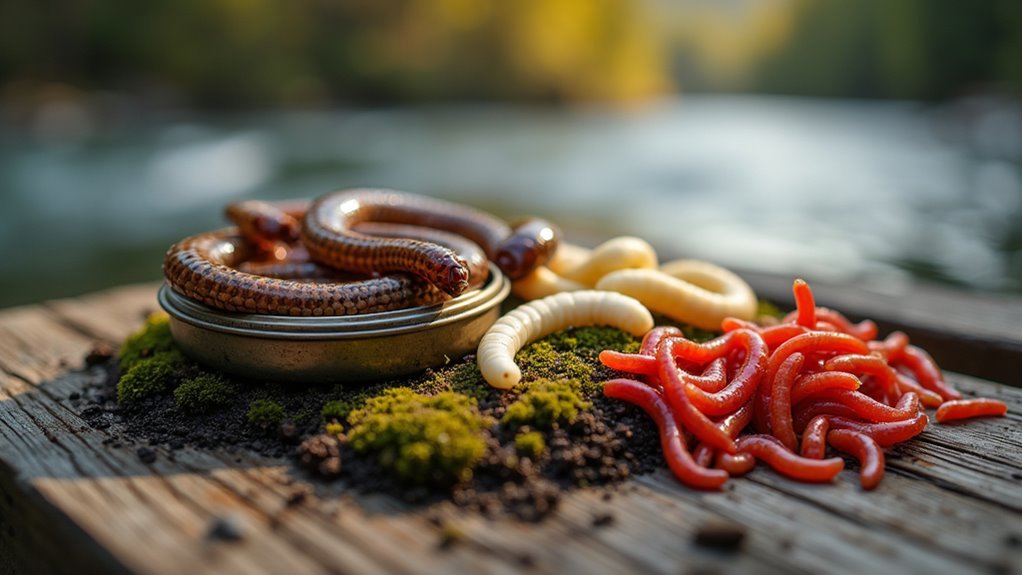Brook trout respond well to a variety of lures and baits, with preferences shifting by season. Metal options like Panther Martin spinners (particularly black with yellow dots) and Phoebe Wobblers create irresistible flash and vibration. For hard baits, Rapala Countdown CD-9s excel in deeper water. Live options such as small shiners and trout worms remain consistently productive, especially for larger fish. Water clarity matters too – silver works in clear conditions while gold performs better in stained water. Understanding these trout preferences transforms your fishing success.
Understanding Brook Trout Feeding Behavior

Why do brook trout strike at certain lures while completely ignoring others?
Understanding the feeding psychology of these fish is perhaps the most essential aspect of successful angling. Brook trout are opportunistic predators, but they’re also surprisingly selective at times.
Their behavior changes with seasons and water conditions. In spring, they might aggressively chase flashy lures that mimic injured baitfish, while summer calls for more subtle presentations.
I think water clarity plays a huge role too – in crystal clear streams, natural presentations work better, whereas in murky conditions, vibration and flash become more important than perfect appearance.
Temperature also affects their willingness to chase fast-moving lures.
Metal Lures: Spoons and Spinners for Brook Trout
Metal lures have maintained their status as brook trout fishing mainstays for generations, with spoons and spinners representing perhaps the most versatile options in an angler’s tackle box.
Their flash and vibration trigger aggressive strikes even in less-than-ideal conditions.
The Phoebe Wobbler and Williams Nipigon stand out among spoons, with their erratic movements mimicking injured baitfish.
For spinners, the Panther Martin—particularly in black with yellow dots—has developed something of a cult following among serious brook trout anglers.
Water clarity should guide color selection; silver works best in clear water, while gold and brighter colors perform better in stained conditions.
Hard Baits: Stickbaits and Crankbaits That Trigger Strikes
While metal lures have their place in a trout angler’s arsenal, hard baits like stickbaits and crankbaits offer distinct advantages when targeting brook trout in certain conditions.
These lures excel particularly in lakes and deeper pools where their swimming action mimics injured baitfish.
The Rapala Countdown CD-9 stands out as perhaps the most effective stickbait for brook trout. Its sinking ability helps reach fish holding in deeper water, and the wounded-minnow action seems irresistible to larger specimens.
Purple, silver, and black color patterns typically produce the best results.
When fishing hard baits, a stop-and-go retrieve often triggers strikes from hesitant trout that might otherwise just follow the lure.
Live Bait Options That Brook Trout Can’t Resist

Hard baits certainly have their appeal, but many experienced brook trout anglers swear by the effectiveness of live bait presentations.
There’s something about the real thing that brook trout simply can’t resist.
Small shiners are perhaps the top choice when targeting larger brookies.
When hunting trophy brookies, nothing outfishes small shiners – they’re the gold standard for serious anglers.
Rigged through both lips and fished under a float, they’re practically irresistible.
Trout worms—those smaller red wigglers—work wonders too, especially on smaller hooks that let the fish take the bait naturally.
And don’t overlook grasshoppers!
During summer hopper hatches, a live grasshopper on a tiny hook might be the most effective presentation of all.
Seasonal Considerations for Brook Trout Lure Selection
As the seasons change throughout the year, so should an angler’s approach to brook trout fishing.
Spring often calls for smaller presentations, perhaps using the Panther Martin spinners in lighter colors when water levels are high and slightly murky.
Summer might require deeper fishing with the Rapala Countdown, especially during midday heat when trout seek cooler depths. I think early mornings work best with topwater approaches.
Fall brings aggressive feeding patterns where Williams Nipigon spoons in gold tones match the ambient colors.
Winter, though challenging, can yield results with slow-jigged Phoebe Wobblers in deeper pools.
Matching Your Tackle to Brook Trout Lure Presentation
Selecting the proper tackle for brook trout fishing remains one of the most overlooked aspects of a successful angling strategy. Many anglers focus solely on lure selection but neglect to match their rod, reel, and line to the presentation.
Tackle selection is the unsung hero of brook trout success, yet most anglers overlook this critical component.
A light-action rod, perhaps 6-7 feet in length, paired with 4-6 pound test line offers the sensitivity needed for detecting subtle strikes.
I think ultralight setups work best with smaller lures like the Panther Martin spinners, while slightly heavier tackle might be appropriate when throwing Rapala Countdowns.
Remember that brook trout have relatively soft mouths, so proper drag settings are essential too.
Frequently Asked Questions
How Do Regional Brook Trout Populations Differ in Lure Preferences?
Mountains to marshlands, brook trout demonstrate regional preferences based on native forage, water clarity, and seasonal patterns. Northern populations favor flashier lures while southern brook trout respond better to subdued presentations.
Can Brook Trout Become Conditioned to Avoid Certain Lures?
Brook trout can indeed become conditioned to avoid specific lures that are frequently used. This behavioral adaptation occurs through negative experiences, making varied presentations essential for continued fishing success in pressured waters.
What’s the Optimal Retrieval Speed for Brook Trout Lures?
Slow and steady, quick and erratic, or variable speeds can all be effective. The ideal retrieval speed for brook trout lures depends on water temperature, clarity, and the specific lure being used.
Do Artificial Scents Significantly Improve Brook Trout Strike Rates?
Studies on artificial scents show mixed results for brook trout. While some anglers report modest improvements in strike rates, natural presentation and appropriate lure selection typically matter more than added scents.
How Do Brook Trout React to Lures During Barometric Pressure Changes?
Studies show brook trout feeding activity drops by 30% during rapidly falling pressure. They typically become more sluggish and less aggressive toward lures before storms, while preferring slower presentations during stable high pressure.